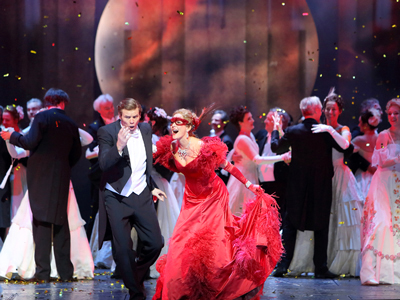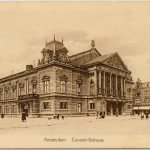by Sedgwick Clark
Three Operas
Far be it for this occasional operagoer to butt heads with Peter G. Davis in a work I barely know. “What are you doing at an Italian opera performance?” he asked me in feigned horror on opening night of the Met’s revival of Verdi’s Macbeth (3/15). “I’m here for the conducting—why else?” I replied, and was pleased to read in his Musicalamerica.com review LINK that we agreed on Gianandrea Noseda’s “maximum of lyrical intensity and dramatic energy—Verdi conducting doesn’t come much better than this.” (Why isn’t Noseda conducting regularly at the New York Philharmonic???) On the other hand, Peter also praised Adrian Noble’s “bold and fearless” 2007 updating of Shakespeare’s Scotland to “a fantasy world that suggests a period roughly around the end of World War II.” Such concepts alienate me; I believe that an intelligent audience will have no difficulty apprehending the composer’s intention in a traditional staging. Most of the time, therefore, my eyes were glommed onto the MetTitles. Thomas Hampson conveyed the weak-willed Macbeth well, if a bit reticently. Verdi said that vocal beauty was not important for Lady M, and Nadja Michael filled the bill; but she emanates sex and temperament aplenty, and I look forward to hearing her in a more refined role—say, Salome or Wozzeck’s Marie. On CD my preference remains Leinsdorf’s 1959 Met recording on RCA with Leonard Warren, Leonie Rysanek, and Carlo Bergonzi.
No problems with the next evening at the Met (3/16)—a superbly sung L’Elisir d’Amore with Juan Diego Flórez (whose shenanigans when he drank the elixir were hilarious) and Mariusz Kwiecien in hot pursuit of Diana Damrau. Peter and I were equally charmed by the 1991 production’s pastel candied sets, but this Saturday matinee is their last hurrah. Catch it if you can!
Leon Botstein may look like a mortician when he takes his bows, but he was at his salesman best in extolling the virtues of the late-Romantic Austrian composer Franz Schmidt in a pre-concert lecture. Franz Who? “He was a fabulous composer.” The occasion was LB’s American Symphony unearthing of the composer’s Notre Dame—which, presumably for marketing reasons, was called “The Hunchback of Notre Dame” in the advertisements—at Carnegie Hall (3/18). “This is a terrific opera. . . . The music is spectacular. . . . It deserves a production.” To an audience member who asked why he was drawn to forgotten music, he said, wryly, “I like slow starters and also-rans. I hate prodigies and competition winners.” This was the personal Botstein we wish for on the podium, and darned if the opera didn’t deserve it. While I can’t agree that Notre Dame is “the equal of any opera on the stage today,” its Wagner-Bruckner-Strauss-Mahler harmonic impasto is a consistent pleasure to hear (“lovely” was the word most bandied around at intermission), and of course it has a compelling story. Let me add my vote to the reviews of Leslie Kandell in Musicalamerica.com LINK and Vivien Schweitzer in the Times that it does deserve a production and Botstein is the man to do it. His conducting and the orchestra’s playing had passion, commitment, and precision, and the singers were uniformly capable, with the leads more so: bass Burak Bilgili as Quasimodo, soprano Lori Guilbeau as Esmeralda, and baritone Stephen Powell as the Archdeacon. The Collegiate Chorale Singers were fine, although it would be nice if they could stand up in unison at curtain time.
Paganini Caprices Humanized
The prospect of hearing all 24 of Paganini’s devilishly difficult Caprices in a single evening, rat-a-tat-tat, seemed rather a chore on the face of it. But Chicago violinist Rachel Barton Pine invested the music with warmth and ease, without stinting an iota on the composer’s fabled virtuosity. Moreover, at suitable intervals she interspersed engaging, often witty comments about the works and the composer that kept the evening moving agreeably. For an encore she performed her own Introduction and Variations on “God Defend New Zealand.” The nearly full house at Rockefeller University’s acoustically attractive Caspary Auditorium (3/21), on the far easterly reaches of Manhattan, caused one to wonder why this talented artist—praised by Harris Goldsmith as a notable up and comer in the 2004 Musical America Directory—isn’t heard regularly at Carnegie Hall or Lincoln Center? Listen to her new Çedille CD “Capricho Latino” and see if you agree.
Murray Perahia, an “Old Master” at His Best
Few are the artists who can lure me back from the country prematurely to hear a Sunday afternoon concert of standards. Murray Perahia is one. Where many attend concerts to hear cherished artists, I’ve always been a repertoire man. My favorites mostly reside in the 20th century. But someone has to carry on tradition, and for my money no one can touch Perahia, as exemplified on Sunday afternoon at Avery Fisher Hall (3/25) in works by Bach, Beethoven, Brahms, Schubert, and Chopin. Moreover, I much prefer solo piano in Fisher over Carnegie’s wetter acoustic, and at this concert Perahia’s American Steinway glowed with the tonal beauty and digital dexterity of the old masters at their best.
A Master Clarinetist at 27
Remember the name: Moran Katz. She’s terrific—a young Israeli clarinetist hailed by Harris Goldsmith in the 2011 Musical America Directory. He wrote of her “magnificent color, agility, and breath control” being “magically persuasive in the early Romantics,” and also of her devotion to contemporary music—all of which she demonstrated vividly in John Adams’s clarinet concerto, Gnarly Buttons, at Zankel Hall soon after the Perahia recital. It’s one of Adams’s most attractive works, witty, virtuosic, but also verging on profundity in the final movement, which Katz rendered movingly. There’s star quality here, waiting for the right management.
The admirable Ensemble ACJW, directed on this occasion by David Robertson, also impressed in Ligeti’s Chamber Concerto for 13 Instruments.
Looking Forward
My week’s scheduled concerts:
3/28 Carnegie Hall. San Francisco Symphony/Michael Tilson Thomas; Emanuel Ax, piano. Ruggles: Sun-Treader. Feldman: Piano and Orchestra. Ives: A Concord Symphony (orch. Brant).
3/29 Zankel Hall. Members of the San Francisco Symphony/Michael Tilson Thomas; Kiera Duffy, soprano; Paul Jacobs, organ; Mason Bates, electronics; Newband; Young People’s Chorus of New York City. Partch: Daphne of the Dunes. Mason Bates: Mass Transmission. Harrison: Concerto for Organ and Percussion Orchestra. Del Tredici: Syzygy.
3/30 Zankel Hall. Members of the San Francisco Symphony/Michael Tilson Thomas, host; Jeffrey Milarsky, conductor; Meredith Monk & Vocal Ensemble; Joan La Barbara, vocalist; Jeremy Denk, piano. Monk: Realm Variations. Reich: Music for Pieces of Wood. Foss: Echoi. Subotnick: Jacob’s Room: Monodrama.
4/2 Leonard Nimoy Thalia at Symphony Space. Cutting Edge Concerts/Victoria Bond, host. Danjam Orchestra, with Peter McNeely, piano; Rufus Müller, tenor; Jenny Lin, piano. Paul Barnes, piano. Daniel Jamieson: Phantasm; A Desperate Act. Jim McNeely: Tod und Feuer; Der Seiltänzer. Victoria Bond: Leopold Bloom’s Homecoming. N. Lincoln Hanks: Monstre Sacré.
4/3 Alice Tully Hall. Juilliard Orchestra/Esa-Pekka Salonen. Sibelius: Pohjola’s Daughter. Beethoven: Symphony No. 7.

